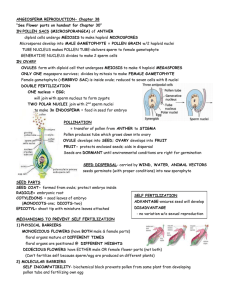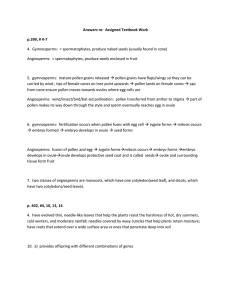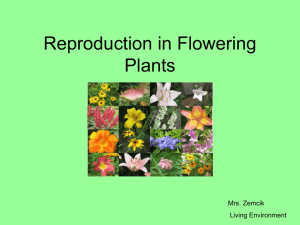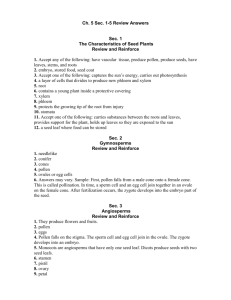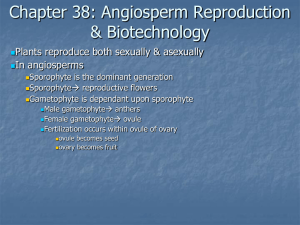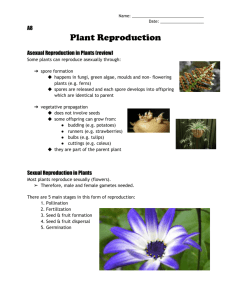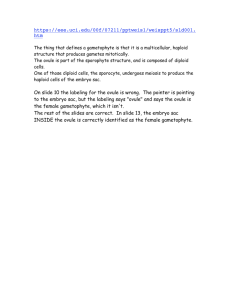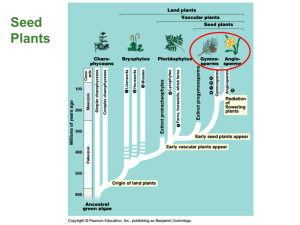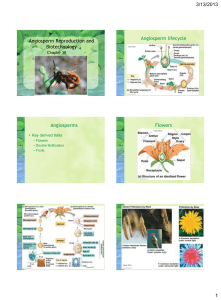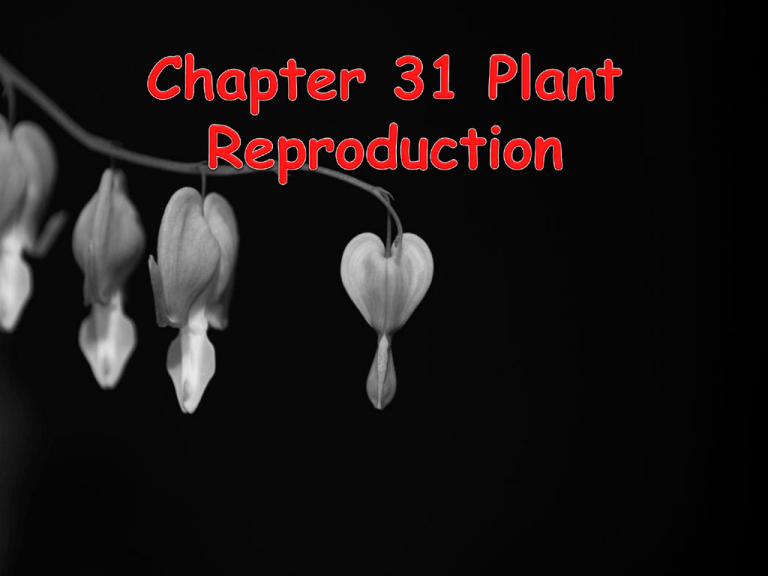
Plants reproduce sexually, often relying
on pollinators to bring sperm and egg
together.
The sporophyte (diploid) develops from
the zygote by mitosis; it consists of
roots, stems, leaves, and flowers
Meiosis of cells within flowers produces
the small haploid gametophytes, which
in turn produce either sperm or eggs.
The specialized parts of the flower grow
from the modified end of the floral shoot –
the receptacle.
Sepals: (collectively called the calyx) are
the outermost green, leaflike parts.
Petals (collectively called the corolla) are
the colored parts of located between the
reproductive structures and the sepals.
Flowers differ from the other tissues of
the plant in their fragrance and colors
(Carotenoids and anthocyanins), which
are attractive to pollinators.
Male parts – called stamens are located
inside the corolla
Stamen consist of a slender stalk (filament)
capped with an anther
Inside the anthers are pollen sacs in which pollen
grains develop
Look at the previous picture to see the male parts
in a diagram
Female parts are located in the central part of
the flower
Carpel is the vessel-shaped structure with an
expanded lower chamber (ovary), slender column
(style) and upper surface (stigma) for pollen
landing.
In ovary eggs develop, fertilization occurs and
seeds mature.
Refer to diagram
Perfect flowers have both male and female
parts (may or may not be on the same plant)
Imperfect flowers is missing one of the sex
In anthers, each diploid “mother” cell divides by
meiosis to form four haploid microspores.
Each microspores will divide to form pollen
grains
One cell in each pollen grain will produce the
sperm; the other will form the pollen tube
In carpel, a mass of tissue forms an ovule (potential
seed) enclosed by integuments.
A diploid “mother” cells divides by meiosis to produce
haploid megaspores, one of which will undergo mitosis
three times to produce a cell with eight nuclei
The nuclei migrate resulting in an embryo sac (female
gametophyte) with seven cells; one cell has two nuclei
and will become the endoperm (nutrition for embryo);
another cell will be the egg
Pollination is the transfer of pollen to the surface
of the stigma by the actions of insects, birds, or
other agents.
In germination, a pollen tube forms producing a
path that the two sperm will follow to the ovule.
When the pollen tube reaches an ovule, it
penetrates the embryo sac, and the two sperm
are released.
One sperm fuses with the egg nucleus to form a
diploid zygote
The other sperm nucleus fuses with the two
endoperm nuclei to yield a triploid “Primary
endosperm cell” that will nourish the young
sporophyte seedling.
The zygote undergoes repeated divisions to
form an embryo sporophyte as a part of an ovule
and is accompanied by formation of fruit.
Cotyledons (seed leaves) develop for the
purpose of utilizing the endosperms during
germination.
From zygote to embyro, the plant supplies
nutrition until the time when the connection
between the ovule and ovary wall is broken
The mature ovule integuments thicken inot seed
coats around the seed (a mature ovule
containing embryo and food reserve)
Embryo is inactive
Seed dehydrates (5 -15% water)
Embryo surrounded by endosperm, enlarged
cotyledons or both
A fruit mature ovary with seeds (ovules) inside;
they may be classified as simple aggregate,
multiple or accessory.
The pericarp of a fruit consists collectively of
endocarp (around the seed), mesocarp (fleshy
portion), and exocarp (the skin)
Immature fruit protects the seed (green, bitter,
sour, etc.)
Mature fruit aids in dispersal (colorful and tasty)
Forms from ovary
Does not provide nutrient for seeds
Seeds have coevolved with particular dispersing
agents – currents of air or water, or animals passing
by
Example: Pericarp of maple seeds extends out like wings
to catch the wing and be transported
Some fruits are dispersed by sticking on animal bodies or by
passing through the digestive tract to be deposited in the
feces
Humans are perhaps the grand dispersing agents by
virtue of the long distances to which they carry seeds
Seed frequently undergo a period of dormancy.
WHY???
Requires water, oxygen, and warm temperatures
Root emerges first. WHY AGAIN?
Vegetative growth modes includes: runners,
rhizomes, corms, tubers, and bulbs.
Parthenogenesis, embryo development from an
unfertilized egg, can produce new orange plants.
Vegetative propagation (“Cuttings”) can result in
new plants produced from leaves that form
roots.
Tissue Culture propagation can result in whole
plants produced from a group of cells.
THE END!!

